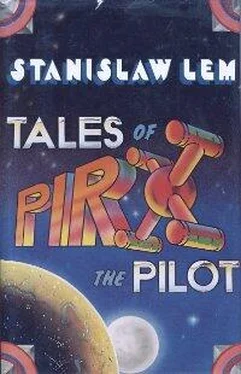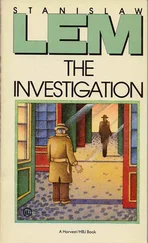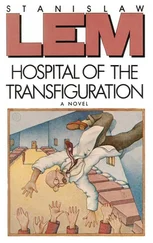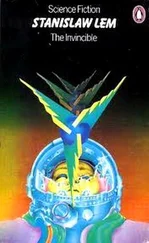Dr. Pnin, noticing how baffled and bewildered Pirx was by all the shop talk, invited him to his room, which was minuscule in size but equipped with a large window that afforded a wonderful view of the massifs eastern summit. A low-lying Sun, gaping like the Gates of Hell, was superimposing on the riot of rock below an anarchy of shadow, an eerie excrescence of black, conjuring behind every boulder a hellish shaft that seemed to lead straight to the Moon’s interior. A dissolution of nothingness into mountain peaks, leaning towers, spires, and obelisks, all sprung from an inky realm; a fire turned to stone, petrified, arrested in midflight; a wild configuration in which the eye quickly lost itself in a tangle of irreconcilable forms, finding dubious relief only in those circular pits of black, those gouged-out sockets brimming with shadow, that were, in fact, the pools of miniature craters.
It was a spectacle like no other. Pirx had been on the Moon several times—which he made a point of reiterating six times throughout the conversation—but never at this time of day, nine hours before sunset. He and Pnin kept each other company for quite a while. Pnin insisted on calling him his “colleague” and “friend,” leaving Pirx to fumble with the grammar to avoid using any direct forms of address. The Russian had a fantastic collection of photos from his moun-taineering days, when he, Ganshin, and three other comrades had gone alpine climbing during a brief furlough Earthside.
Attempts had been made to coin the phrase “Moon climbing,” but it failed to catch on, the term “Lunar Alps” only confusing the issue.
Pirx, an ardent climber himself, even before his matriculation into the Institute, had found in Pnin a soulmate. He asked him how lunar mountain climbing differed from mountaineering on Earth.
“As a rule of thumb,” Pnin said, “use the same techniques you would use back home. There is no ice up here—except, and then only rarely, in very deep cracks. And no snow, either, of course. That makes the climbing look deceptively easy. What makes it even more deceiving is that you can take a thirty-meter fall without seriously injuring yourself. But never let that enter your head.”
Pirx looked puzzled. “Why is that?”
“The lack of atmosphere,” Pnin explained. “No matter how long you work the terrain, you’ll never get the knack of judging distances. Not even with a telemeter—besides, who wants to lug around a telemeter? It’s like this. You’ll scale a peak, look over the side of a cliff, and swear it’s fifty meters down. Maybe it really is fifty, but it could just as well be five or ten times that. I remember once… Well, anyway, you know the old saying. Once you tell yourself you’re going to fall, sooner or later you will. Fracture your skull on Earth and it will heal. Here, one solid jolt on the helmet, a punctured visor—and it’s all over. So don’t forget. When you climb, do the same things you would normally do in mountainous terrain; take the same chances you would take Earthside. With one exception: ravines. Even if it looks like only ten meters across—that’s a meter and a half by Earthly standards—toss a rock over to the other side and observe its flight. But my advice—my sincere advice—is: avoid any jumps. Because once you’ve cleared twenty meters, no cliff will seem too steep, no mountain too high. And remember, there’s no mountain rescue service up here…”
Pirx inquired about the Mendeleev station. Why was it built high up under the ridge and not down below? And was it a rough climb?
“No, not really. Only a few outcrops left by the slides, up around the gap—the road, you see, was wiped out by the avalanche. It would be tactless of me to comment on the choice of location, especially after what happened… But surely you must have read about it.”
Pirx flushed with embarrassment and stammered something about having had exams at the time. Pnin smiled, then turned grimly serious.
“Well, to begin with… The Moon has become internationalized; each country has its own sphere of scientific research—this hemisphere, for example, belongs to us. When it turned out that the Van Allen Belt was interfering with the process of cosmic radiation on the side facing Earth, the English asked our permission to build a station in our hemisphere. We agreed to it. Since we were at work on a station of our own on Mendeleev, we proposed they take it over from us, provided they reimburse us for materials already accumulated. They accepted but then turned the project over to the Canadians. Well, English or Canadians, it made no difference to us. Since we had already conducted a preliminary land survey of the area, one of our group, Professor Animtsev, was invited to join the Canadian planning team as a consultant on local conditions. Then we learned that the English wanted back in. They sent out their man Shanner, who advised that secondary radiation pencils at the bottom of the crater could adversely affect future research. Our experts disagreed, but by this time the English had decided to make the station their own and to locate it just under the ridge. Costs skyrocketed, with the Canadians agreeing to foot the bill. But that was none of our business. We don’t go around peeking into other people’s pockets.
“Anyway, once the site was selected, a road survey was done. Animtsev tipped us off that the British were planning to lay concrete bridges across the ravines along the projected route but that the Canadians had rejected the idea as being too costly—double the original estimate. They decided to blast two ribs into the face of Mendeleev, using directional charges. I warned them that they ran the risk of disturbing the equilibrium of the basalt’s crystal core. But they wouldn’t listen. Well, what could we do? They weren’t kids, you know. We had all the selenological experience on our side—but then we thought if they won’t listen, we can’t force them to take our advice. Animtsev cast his dissenting vote, and that was that. They started blasting. One silly mistake compounded by another. The English built three slide barriers, got the station up, and brought in their crawler transports. So far, so good. But the station wasn’t three months in operation when, at the foot of the overhang, just under the Gap—the ridge’s western pass—cracks started to appear…”
Pnin got up, opened a desk drawer, and produced several large photographs.
“There,” he said, pointing to the cracks, “you’re looking at what is—or was—a kilometer-and-a-half-long wall. The road ran roughly a third of the way up the side—there, where you see that red line. The Canadians were the first to sound the alarm. Animtsev—who had hung around, still trying to convince them of their errors—told them, ‘Look, there’s a three-hundred-degree difference in temperature between day and night. The cracks are sure to expand. It’s no use. You can’t shore up a kilometer-and-a-half-long wall! Close the road, and since the station is already up, build a cable railway up there.’ Well, they began calling in the experts—from England, Canada… It was a farce: those who corroborated Animtsev’s opinion headed back as fast as they had come. The only ones left were those who advocated—cement. Yes, that’s right. They began pouring cement into those cracks. They injected, they put up abutments, they injected more cement, then more abutments, because whatever they cemented during the day would crack overnight. By this time the couloirs were beginning to spill over, but the walls held. To divert any worse slides they put up a system of wedges. That’s when Animtsev told them: ‘You’re worried about a few landslides when the whole wall is about to cave in!’
“Poor Animtsev. I couldn’t bear to look at him when he came to see us. The man was frantic. He could see it coming but was helpless to do anything about it. Granted, the English have their share of top-notch specialists. But, you see, this wasn’t a problem for a specialist, it wasn’t a selenological problem. Their prestige was at stake! They had built that road and were damned if they were going to back out. Animtsev protested for the umpteenth time and finally resigned. We later heard that the English and Canadians had quarreled about what to do with the wall—the shoulder of what’s known as the Eagle’s Wing. The Canadians were all for blowing it up—let’s destroy the road, they said, and build a safer one later on. The English didn’t like the idea. Anyway, it was wishful thinking; Animtsev estimated it would have taken a six-megaton hydrogen blast, and the UN charter expressly prohibits the use of radioactive materials as explosives… Well, they kept bickering back and forth until, finally, the wall really did collapse… The English wrote that it was all the fault of the Canadians for having rejected their original proposal—those concrete viaducts…”
Читать дальше











